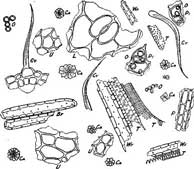
Pilocarpine, Jaborandi, Pilocarpus Jaborandi, pinnatifolius
 Powder of Pilocarpus under magnification artist rendering
Powder of Pilocarpus under magnification artist rendering
Pilocarpus and Pilocarpus
Pilocarpus or Jaborandi (U.S.P. 1882 to 1916) consists of the leaflets of Pilocarpus Jaborandi Holmes (Pernambuco Jaborandi, 1894 to 1916); of Pilocarpus microphyllus Stapf (Maraham Jaborandi, 1905 to 1916); or of Pilocarpus pinnatifolius Lemaire (Paraguay Jaborandi, 1882 to 1894) (Fain. Rutacese). The plants are shrubs indigenous to Brazil.
Pernambuco jaborandi is elliptical, lanceolate or oblong-lanceolate, 6 to 12 cm. in length, 1.5 to 4 cm. in breadth; summit obtuse, more or less emarginate; base rounded or acute, unequal; margin entire, slightly revolute; upper surface dark green or brownish green, glabrous; under surface yellowish or greenish brown, pubescent, with numerous light brown projections, midrib prominent; glandular-punctate; texture coriaceous, brittle; odor slight; taste bitter, somewhat aromatic, becoming pungent.
Paraguay jaborandi is somewhat broader, sometimes obovate, thinner and less coriaceous and frequently with black disk-like fruits of a species of Puccinia on both surfaces.
Maranham jaborandi is smaller, coriaceous but rather thin, and frequently bearing the same Puccinia fruiting heads as found on Paraguay jaborandi. All of the commercial kinds of pilocarpus yield from 0.5 to 1 per cent of the alkaloid pilocarpine, also isopilocarpine and jaborine.
Pilocarpine is the lactone of pilocarpic acid, an acid having a glyoxaline nucleus. It is an oily, syrupy liquid, though its salts crystallize easily. It is usually obtained by treating the powdered leaves with sodium carbonate, extracting with benzene and then shaking the benzene extract with dilute hydrochloric or nitric acid. The aqueous solution is then made alkaline and shaken with chloroform; the chloroformic solution then shaken with acid and the alkaloidal salt allowed to crystallize.
Pilocarpine Hydrochloride (U.S.P. 1882 to 1936, 1950 to date; N.F. 1936 to 1950) is the hydrochloride of an alkaloid obtained from the dried leaflets of Pilocarpus Jaborandi Holmes or of Pilocarpus microphyllus Stapf (Fam. Rutacese). It is hygroscopic. Pilocarpine Nitrate (U.S.P. 1905 to date) is the nitrate of the alkaloid. It is stable in air but is affected by light.
DESCRIPTION AND TESTS.—Pilocarpine Hydrochloride occurs as colorless, trans-lucent, odorless, faintly bitter crystals; the nitrate occurs as shining, white crystals. For the formulas, characteristics, and tests consult the U.S.P. XV.
USES AND DOSE.—The alkaloidal salts are preferred to galenicals prepared from the drug. Both the hydrochloride and the nitrate are parasympathomimetics and are used as diaphoretics, sialagogues, and myotics. Usual dose, oral and subcu-taneous, 5 mg.; for external use, topically as a 0.5 to 2 per cent solution to the conjunctiva.
This information was taken from....
Gathercoal and Wirth “PHARMACOGNOSY” By Edward P. Claus, Ph.D. Professor of Pharmacognosy and Head of the Department, University of Pittsburgh School of Pharmacy, Member of the Advisory Panel on Pharmacognosy National Formulary (Third Edition, Thoroughly Revised 306 1956)